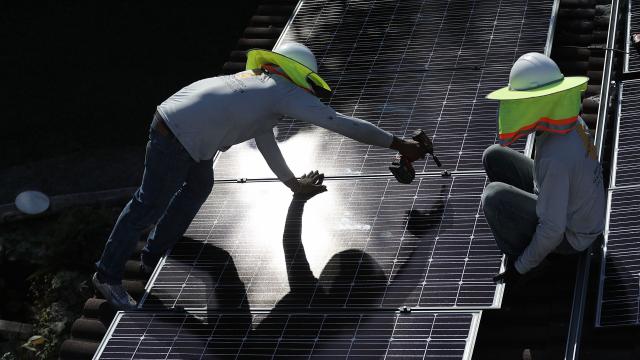Since coronavirus began to creep across the U.S., 17 million people have filed for unemployment. And with no end to the pandemic in sight, that number is projected to go way up.
The spread of the novel coronavirus has affected nearly every corner of the American economy, including the clean energy sector. More than 106,000 people working in the clean energy sector lost their jobs in March alone, according to a new analysis of Department of Labour data produced by clean energy advocates and researchers at Environmental Entrepreneurs, American Council on Renewable Energy, E4TheFuture and BW Research.
That’s about triple the rate of job loss in the U.S. economy, as reflected by unemployment filings. Many more workers have likely lost jobs in the two weeks since. And in the months ahead, the industry could shed 15 per cent of its workforce, leaving half a million people unemployed by June”unless the White House and Congress take action soon.
The clean energy sector, which includes renewable energy, energy efficiency, and electric and hybrid cars, employed more than 3.4 million Americans by the end of 2019.
“By comparison, only about 50,000 people work in the coal industry in America and about 145,000 work in oil and gas extraction. “ Bob Keefe, executive director of Environmental Entrepreneurs, told reporters on Wednesday. “Imagine how quickly the White House would be moving about 50,000 coal workers and all those petroleum workers were suddenly out of a job.”
The job losses in clean energy are already a huge issue but losing 500,000 clean energy workers would be catastrophic for the growing industries, which a separate report released by Environmental Entrepreneurs on Wednesday shows added over 70,000 jobs to its workforce in 2019. The sector grew by 10.4 per cent since 2015, according to the Labour Department and has been growing faster than the American economy at large for the past five years.
Two-thirds of the clean energy jobs lost so far were in the energy efficiency sector. Some 70,000 electricians, technicians, and construction workers who install air conditioning, heating, plumbing and efficient appliances are among the heaviest job losses. The wind and solar sector also lost more than 16,000 lost jobs, and the electric and hybrid auto industry lost 12,000″and that doesn’t even include the 20,000 workers furloughed by Tesla. Before the pandemic hit, the Bureau of Labour Statistics projected that solar installers and wind turbine service technicians were going to be the two fastest growing jobs in the U.S. over the next decade.
So far, federal lawmakers haven’t prioritised these industries in crafting covid-19 stimulus packages. But with more stimulus bills likely coming, it’s not too late.
“Lawmakers don’t have to sit back and watch clean energy crumble and its 3.4 million workers suffer,” Keefe wrote in a blog post. “They should heed the warning signs and act quickly and decisively with policies that can stem the losses.”
In a letter to leaders on Capitol Hill, Keefe’s organisation provided a long list of policy recommendations to help the sector. For one, Congress and the White House could extend the window to apply for for tax incentives for renewable energy projects.
“These deadlines don’t apply to the cash incentives for other forms of energy, for fossil fuels,” said Keefe. “But renewable tax credits have very finite timelines and have to be completed promptly or they lose qualification for the credit and that undermines the whole financial model. So we are seeking an extension of the timeline.”
Congress could also increase investment in the Department of Energy’s Weatherization Assistance Program, which provides funding for energy efficiency upgrades in low-income households. Federal and state lawmakers could even pour funds into programs to replace diesel-fuelled school buses with electric ones and weatherize school buildings, particularly if they remain closed due the pandemic.
“There’s something like 98,000 schools across our country that are sitting vacant and they probably will be until September,” said Keefe. “Why can’t we get energy efficiency workers in those buildings sooner than later?”
These proposals could not only create jobs. Thee could also save municipalities money because transitioning to renewable can costs as can efficiency. That could be helpful to cities and states that will have to balance their budgets as well as individuals struggling to make ends meet as coronavirus wreaks havoc on the economy.
“Not only do we have the opportunity to protect the jobs in the energy efficiency and clean energy sector but we have the opportunity to really use energy efficiency as an opportunity to give relief to businesses and homeowners that are struggling through the challenges of the pandemic,” said Tina Bennett, president and CEO of CMC Energy Services, on the press call.
Of course, moving toward renewable energy isn’t just a way to create jobs and save money. The future of our country and the planet depend on us moving away from fossil fuels right now.
